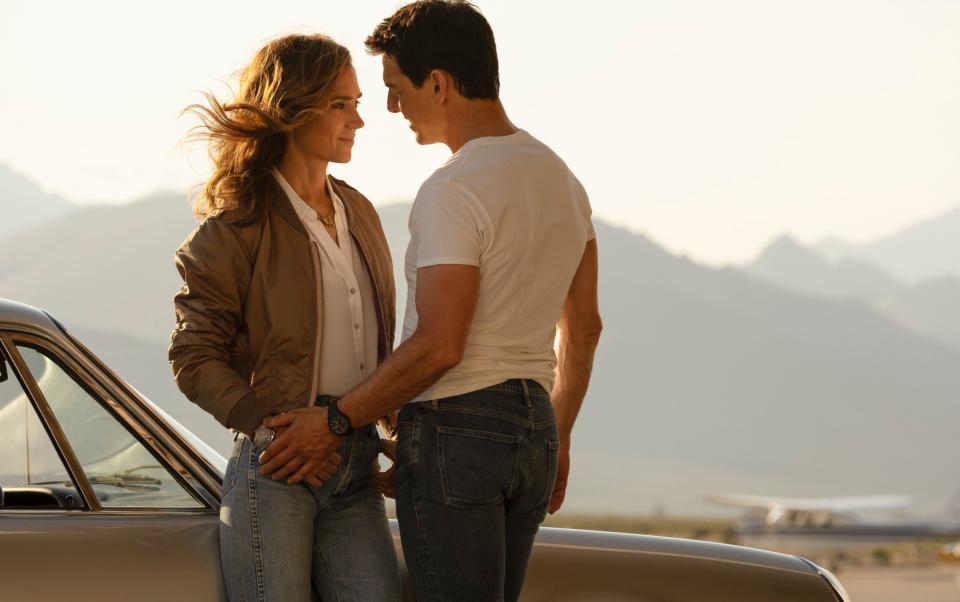Top Gun: Maverick: Tom Cruise makes an absurdly exciting return to the skies

A bruised dawn breaks over a US Naval test base somewhere on the American west coast. Inside a hangar basks a stealth jet, rippled and lean, and theoretically capable of hitting ten times the speed of sound. This record has yet to be reached, though – and an admiral nicknamed the Drone Ranger is on his way to decommission this wondrous instrument, so the leftover funds can be channeled back into his pilotless programme.
“Unmanned” is the term the crew wincingly use, though “unmanly” is more like it. Their own man – short, dark and farcically handsome – is hungrily eyeing the cockpit. The admiral isn’t due to arrive for another few minutes. “They want Mach 10?” he says, flashing a smile like a floodlight. “Let’s give them Mach 10.”
This moment in Top Gun: Maverick’s opening minutes feels like watching Tom Cruise tune up before a career-defining concert – a backstage sotto voce pledge on which he thunderously delivers. More than a decade has passed since Cruise’s reinvention of himself as an improbable but highly watchable cross between Paul Newman and Usain Bolt, and with this late sequel to 1986’s Top Gun – which turned the actor from a heartthrob to a household name – we have surely arrived at the Cruisiest film he’s yet made.
That might be the same thing as saying it’s one of his best – and it is unquestionably the best studio action film to have been released since 2015’s Mad Max: Fury Road. It is also Dad Cinema at its eye-crinkling apogee: all rugged wistfulness and rough-and-tumble comradeship, interspersed with flight sequences so preposterously exciting and involving they seem to invert the cinema through 180 degrees.
Today, the first Top Gun – directed with great style by the late Tony Scott – can feel like a bit of a cave painting. But in its time, it was instrumental in bringing the visual potency of advertising to Hollywood, and marked the point at which studios realised movies could be commercials for themselves. This follow-up, directed by Joseph Kosinski, deals in the same unexpected-itch-scratching bliss: it’s crammed with images you didn’t know you were desperate to see until the second you see them.
But it also contrives a sleek and surprisingly moving plot that brings an additional thrust of sentimental G-force to the thrill ride, and builds to an ending guaranteed to unfold to an impromptu soundtrack of stifled manly sobs.
Within minutes of the opening credits, Cruise’s Maverick is recalled to his old Top Gun stomping ground, where a small group of recent graduates have been assembled for a sickeningly deadly mission overseas. The class are a handsome, crisply defined bunch, and each has the obligatory snappy call sign: Glen Powell is the deliciously smug Hangman, Monica Barbaro the pioneering female recruit Phoenix, and a superb Miles Teller the gifted loose cannon Rooster – son of Maverick’s former wingman Goose, whose death in the previous film has left Maverick scarred.
The assignment involves neutralising a uranium enrichment plant somewhere overseas, though we’re told details about the enemy regime behind it are “scarce” – as they have to be these days when you’re trying to sell a blockbuster into as many overseas markets as possible. Certain military details suggest it might be Iran, but it doesn’t matter either way: the film is low on militaristic swagger, and instead focuses on Maverick’s missionary-like determination to have these youngsters not just reach their potential but surpass it, with the help of their extraordinary aircraft.

Watching Cruise’s return as Maverick is so outrageously pleasurable largely because the actor himself treats it as pleasure. When he first arrives back on the base on his trusty Kawasaki, he allows himself a grin of recognition that seems to come simultaneously from both the character and performer – a can-you-believe-we’re-back nod to the audience that feels like an almost conspiratorial, fourth-wall-breaking moment, and the kind of tiny detail that requires a whole career’s groundwork to convincingly pull off. And the screenplay wisely creates some ironic distance around Maverick’s unflagging self-belief: there is a great supporting role for Jon Hamm as the Vice Admiral who has to look constantly furious about our hero’s unconventional methods.
There is also a neat, lower-key role for Jennifer Connolly as an old flame, and a touching return for Val Kilmer, whose Iceman is now a highly decorated Admiral with health problems that mirror the actor’s own. Again, the line between actor and character is blurred, and the obvious difference between the two men’s physical conditions 36 years after their pin-up days brings an affecting edge to what could have easily been an empty play for nostalgia.
As for the flight scenes themselves, Cruise’s reported insistence on shooting in real F/A-18 Super Hornets has given the action scenes a breathtaking beauty and urgency: the play of light and gravity on the actors’ faces, and the way the landscapes spin and drop away balletically through the canopy glass, puts other blockbusters’ green-screened swooping to shame. In at least two hairy moments, a supporting character tells Maverick that they don’t like the look on his face, to which he shruggingly replies: “It’s the only one I got.” It is also the only face that could possibly carry this absurdly entertaining film.
12A cert, 131 min. In cinemas now


